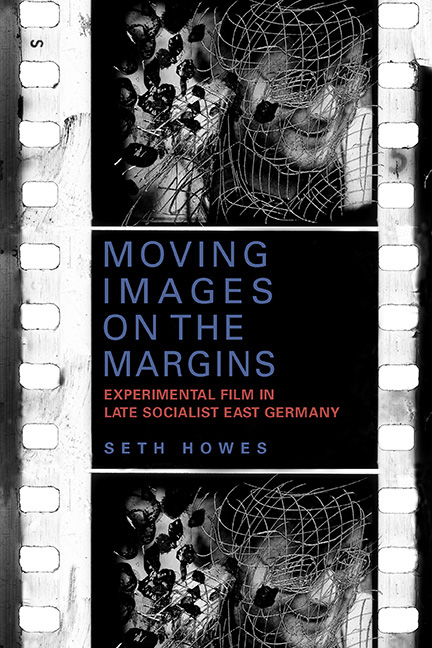Book contents
- Frontmatter
- Dedication
- Contents
- List of Illustrations
- Acknowledgments
- Introduction
- 1 Art, Experimentation, and the Avant-Garde in East Germany
- 2 Heraklesmaschine: Lutz Dammbeck's Experimental Cinema and the Expropriation of the Senses
- 3 Lines of Communication: Mail Art and the Connectivity of Experimental Film
- 4 Herz Horn Haut Schrein: Film and the Autoperforating Body of/at Work
- 5 Film Experiments, Design Anthropology, and the Politics of Vision: Yana Milev's Theory of Practice
- Conclusion: Images of Moving Margins
- Notes
- Bibliography
- Index
Conclusion: Images of Moving Margins
Published online by Cambridge University Press: 21 March 2020
- Frontmatter
- Dedication
- Contents
- List of Illustrations
- Acknowledgments
- Introduction
- 1 Art, Experimentation, and the Avant-Garde in East Germany
- 2 Heraklesmaschine: Lutz Dammbeck's Experimental Cinema and the Expropriation of the Senses
- 3 Lines of Communication: Mail Art and the Connectivity of Experimental Film
- 4 Herz Horn Haut Schrein: Film and the Autoperforating Body of/at Work
- 5 Film Experiments, Design Anthropology, and the Politics of Vision: Yana Milev's Theory of Practice
- Conclusion: Images of Moving Margins
- Notes
- Bibliography
- Index
Summary
ON JUNE 30, 1990, at the age of twenty-eight, ‘Matthias’ BAADER Holst was fatally struck by a streetcar. The streetcar was turning the corner of Oranienburger Straße and Friedrichstraße in Berlin. Visit the intersection today, and the Dada Falafel restaurant is the closest thing to a sign that Holst ever passed through, because its name might bring to mind one of the two sources of Holst's self-appended middle name: Johannes Baader, the Dadaist provocateur and performer. The other source, Red Army Faction member Andreas Baader, was of more recent vintage—and had little to do with Berlin. Educated in Halle, the son of a university administrator and an English professor, Holst coedited his own samizdat periodical Galeere, wrote for other little magazines, produced handmade artists’ books and mixed-media collages, and fronted the punk bands Die letzten Recken and Frigitte Hodenhorst Mundschenk. He also performed his texts orally in many of the galleries, churches, studios, and apartments mentioned throughout this book, even collaborating with Yana Milev at the live events connecting films to performances discussed in the previous chapter.
Hardly poetry readings in the conventional sense, Holst's exhortative monologues have prompted agitated, intense reconstructions in critical and journalistic prose. In one of the few academic studies of Holst to appear to date, Eric Steffen describes Holst ‘throwing his body completely into it’ when ‘he shrieked, sobbed, and danced his texts as a chaotic pogo that offered a corporeal performance of the collapse of the linguistic world,’ and Die Zeit's Martin Brinkmann recalls a Brachialdichter: a ‘brutal poet.’ And Holst's closest collaborator, Peter Wawerzinek, recalls that when looking for a performance partner, he found in Holst ein Dichter mit Mumm, a poet with animus, ‘who conveys his poetry, throws himself into the thick of things for his writing, his texts, his life. Lets out what's held in. Speaks aloud what needs to be said. Gives a unique viewpoint, heft, and language to the state of things.’ Wawerzinek places Holst's body at the center of his creative endeavors: audible, producing a voice with grain, pitch, and timbre; visible as an object of sight; and present as an extended material object, capable of exerting force or being acted upon.
- Type
- Chapter
- Information
- Moving Images on the MarginsExperimental Film in Late Socialist East Germany, pp. 173 - 182Publisher: Boydell & BrewerPrint publication year: 2019



